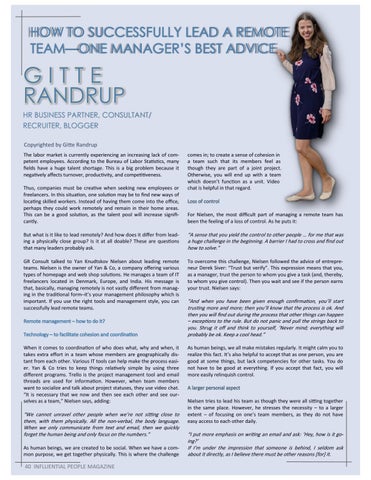HOW TO SUCCESSFULLY LEAD A REMOTE TEAM—ONE MANAGER’S BEST ADVICE
GITTE RANDRUP HR BUSINESS PARTNER, CONSULTANT/ RECRUITER, BLOGGER Copyrighted by Gitte Randrup The labor market is currently experiencing an increasing lack of competent employees. According to the Bureau of Labor Statistics, many fields have a huge talent shortage. This is a big problem because it negatively affects turnover, productivity, and competitiveness. Thus, companies must be creative when seeking new employees or freelancers. In this situation, one solution may be to find new ways of locating skilled workers. Instead of having them come into the office, perhaps they could work remotely and remain in their home areas. This can be a good solution, as the talent pool will increase significantly.
comes in; to create a sense of cohesion in a team such that its members feel as though they are part of a joint project. Otherwise, you will end up with a team which doesn’t function as a unit. Video chat is helpful in that regard. Loss of control For Nielsen, the most difficult part of managing a remote team has been the feeling of a loss of control. As he puts it:
But what is it like to lead remotely? And how does it differ from leading a physically close group? Is it at all doable? These are questions that many leaders probably ask.
“A sense that you yield the control to other people … for me that was a huge challenge in the beginning. A barrier I had to cross and find out how to solve.”
GR Consult talked to Yan Knudtskov Nielsen about leading remote teams. Nielsen is the owner of Yan & Co, a company offering various types of homepage and web shop solutions. He manages a team of IT freelancers located in Denmark, Europe, and India. His message is that, basically, managing remotely is not vastly different from managing in the traditional form–it’s your management philosophy which is important. If you use the right tools and management style, you can successfully lead remote teams.
To overcome this challenge, Nielsen followed the advice of entrepreneur Derek Siver: “Trust but verify”. This expression means that you, as a manager, trust the person to whom you give a task (and, thereby, to whom you give control). Then you wait and see if the person earns your trust. Nielsen says:
Remote management – how to do it? Technology – to facilitate cohesion and coordination When it comes to coordination of who does what, why and when, it takes extra effort in a team whose members are geographically distant from each other. Various IT tools can help make the process easier. Yan & Co tries to keep things relatively simple by using three different programs. Trello is the project management tool and email threads are used for information. However, when team members want to socialize and talk about project statuses, they use video chat. “It is necessary that we now and then see each other and see ourselves as a team,” Nielsen says, adding:
“We cannot unravel other people when we’re not sitting close to them, with them physically. All the non-verbal, the body language. When we only communicate from text and email, then we quickly forget the human being and only focus on the numbers.” As human beings, we are created to be social. When we have a common purpose, we get together physically. This is where the challenge
40 INFLUENTIAL PEOPLE MAGAZINE
“And when you have been given enough confirmation, you’ll start trusting more and more; then you’ll know that the process is ok. And then you will find out during the process that other things can happen – exceptions to the rule. But do not panic and pull the strings back to you. Shrug it off and think to yourself, ‘Never mind; everything will probably be ok. Keep a cool head.” As human beings, we all make mistakes regularly. It might calm you to realize this fact. It’s also helpful to accept that as one person, you are good at some things, but lack competencies for other tasks. You do not have to be good at everything. If you accept that fact, you will more easily relinquish control. A larger personal aspect Nielsen tries to lead his team as though they were all sitting together in the same place. However, he stresses the necessity – to a larger extent – of focusing on one’s team members, as they do not have easy access to each other daily.
“I put more emphasis on writing an email and ask: ‘Hey, how is it going?’ If I’m under the impression that someone is behind, I seldom ask about it directly, as I believe there must be other reasons [for] it.











